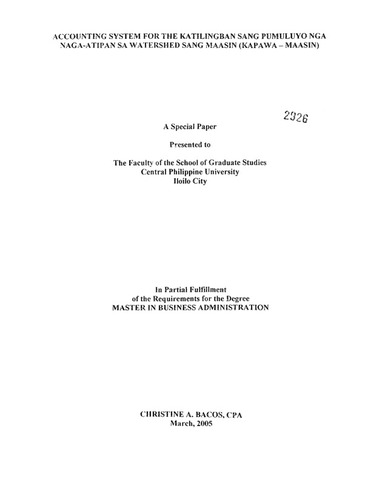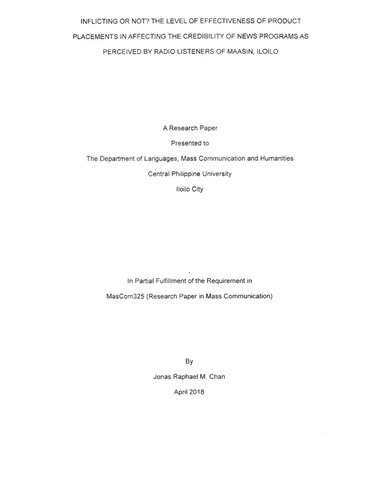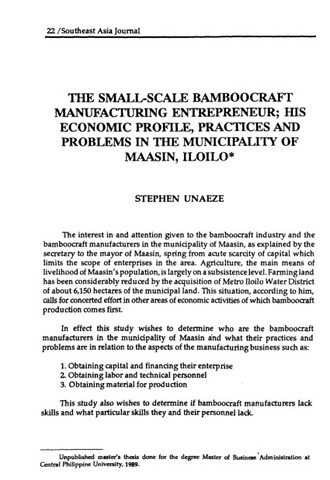| dc.description.abstract | Background and Rationale of the Proposed Accounting System.
The Katilingban sang Pumuluyo nga naga-Atipan sa Watershed sang Maasin (KAPAWA - Maasin) is located within the Maasin Watershed in the Municipality of Maasin, Province of Iloilo, in the Western Visayas Region. The main office is located at Mabini-Rizal Sts., Maasin, Iloilo, while its field office is at Brgy. Bolo, Maasin, Iloilo, around 34 kms. Nortwest of Iloilo City.
It was in 1990 when it came to a point that a problem of resource degradation brought about by destructive farming within the watershed area became unendurable - slit laden floods during the rainy season and drying up of creeks during the summer months. To save Maasin Watershed from irreversible damage, the government and civil society launched a movement with a slogan “Year 2000 Iloilo City: No Water”. Many responded - schools, military, media, national and local government, donor agencies and other sectors of the civil society. Vast expanse of the watershed was replanted but only few areas survived. The reason behind was that the local communities were not involved in the movement - they do not understand its objectives and perceived tree planting as inimical to their economic interest. They uprooted the newly planted seedlings and nonchalantly grazed their carabaos in the plantation area.
History taught them so many lessons and one of them was that any attempt at watershed rehabilitation is bound to fail if they didn’t have the wholehearted support of the local communities. It was then in August 15, 1997 when KAPAWA-Maasin was federated under Bureau of Rural Workers (BRW) Registration No. VI-930.
The same year, the DENR has contracted the federated organization (KAPAWA-Maasin) to undertake the Comprehensive Site Development (CSD) as implemented by the Forestry Sector Project (FSP - Sub-Project). The area of 3,415.92 hectares had been delineated as subproject for the Forestry Sector Project funded by the Japan Bank for International Cooperation (JBIC) which comprises 46% of the total area of the watershed. Only 2,685 hectares for CSD has been earmarked for development which is categorized into 1,000 hectares for reforestation; 1,164 hectares for agroforestry; 300 hectares for bamboo; 161 hectares for rattan; and 60 hectares for the rehabilitation of river/creek banks.
In December 2002, DENR entrusted the stewardship of the rehabilitated portion of the watershed to KAPAWA by virtue of Community Based Forest Management Agreement (CBFMA) No. 38416. This framework plan is a vehicle for the attainment of the avowed responsibility of KAPAWA in the said agreement - to push forward the CBFM Area to sustainable development.
The contract started in August 1997 and was originally expected to end in December 2000 with a total contract cost of P44,269,143.00. The CSD contract was further amended and given extension up to June 30, 2003 giving the People’s Organization (PO) ample time to fully plant and replant backlogs and to perform other developmental activities that were not met during the period of the original contract. Contract cost has also undergone series of changes from the original CSD cost.
In January 2003, another adjustment was made where an amount of P5,613,111.18 was deducted from the adjusted contract cost which comprised the Contingency Cost and other unutilized amount per Memorandum of the Undersecretary for ENR Operation dated September 2002. It was only then, that the rehabilitation of 2,685 hectares (or more than half of the denuded portion of the watershed) became certain.
Maasin Watershed Subproject comprises of ten (10) barangays in the Municipality of Maasin, five (5) Barangays in the Municipality of Alimodian and one (1) barangay in the Municipality of Janiuay.
After the contract with the DENR, KAPAWA was entrusted with the task of maintaining the watershed area, but operates as self supporting organization of 1,742 members coming from 16 member-organization, chaired by Ms. Merilyn C. Piojo to oversee its operation. The DENR gave the Contingency Cost to the federation and this formed part of the initial capital used to start its livelihood operations.
To sustain and improve the way of life of the members and their families, the federation ventures to different livelihood projects that are compatible with the CBFM Area and suitable to different levels of the organization. Among the livelihood projects managed by the KAPAWA were Rice Trading, Public Utility Vehicle, Trucking Service, Motorcycle Loan, Sawali Production & Trading, Seedling Production, Feeds Trading and Hog Fattening, but due to inadequate technical skills and training of the members some of these projects were stopped.
At present, the federation offers variety of goods for sale to the members and customers. These goods are bamboo products, amakan & kisame; abaca fibers; rice and by-products. They also offer services like, PUJ transport, Trucking services and loan facility. Some products coming from CBFM Area are sold to the PO, which in turn will sell these products to the KAPAWA federation. The federation serves as the marketing arm or one that stores, processes, transports and sells these products to target markets.
The KAPAWA also receives assistance from different institutions, the Environmental Science for Social Change (ESSC), Forestry Sector Project (FSP), Subproject Site Management Office (SUSIMO) and Efren C. Gerardino the FSP Assiting Professional. At present, Central Philippine University (CPU) is also one of the institutions that adopt the federation through its CPU outreach committee in cooperation with its departments, specifically Education and Accountancy.
As an independent organization composed of sixteen (16) member- organization, it experienced problems on not be able to manage and account for the livelihood funds they loaned out to its members. It also could not properly present to its members the financial position and performance of the livelihood projects that they are engaged in, after six months of operation.
Hence, in July 3, 2004, Mrs. Merilyn C. Piojo, chairman of the federation (KAPAWA - Maasin), together with the vice chairman requested the assistance of CPU through its outreach program committee for a Seminar-Workshop on Simple Bookkeeping, Financial Statements Preparation and Accounting System to educate them the proper accounting, recording and preparations of their financial transactions including different books of accounts to be used. The CPU-accountancy department responded by sending resource speakers to facilitate the said activity and the proponent was one of them.
Aside from the above activities, the officers also requested for a total financial and operations audit of the federation. It was then when the proponent discovered the following: 1) that there is no structured or formal accounting system for the KAPAWA - Maasin, although, it already operates under undocumented procedures with certain reports and few forms prepared; 2) that financial statements were prepared from informal, incomplete source documents; 3) that there is no clear delineation of functions and/or responsibilities, and 4) that employees were not given proper training on financial management aspect to better appreciate their roles as employees in the organization.
Based on the above findings, the proponent and the officers of the federation realized the legitimate need of the federation for a formalized and documented manual accounting system and to fill this need, with the permission from the officers of the KAPAWA-Maasin and the chairman of the accountancy department, the proponent decided to design this system for the federation. The proposed accounting system is customized and designed in a very flexible manner, in case of change of set-up within the organization or under a computerized environment.
Several studies have been made on the importance of accounting system in an organization. Mrs. Gloria G. Biado on her special paper “Accounting System: A Descriptive Study” of Jaybee Foods, Inc. found out that the description of an accounting system showed a relationship of personnel performing operating and recording processes, accountable prenumbered documents and other predesigned forms and reports required of management and government regulatory agencies. One of her recommendations is that a written description of an accounting system is a must for every business entity.
Professor Lorna T. Grande on her research-study on Central Philippine University Student Service Enterprise (CPUSSE) operations particularly on “the perceptions of the consumers-respondents as basis for proposals for improvements” suggested that, “there is a need to improve its operation in order to satisfy the needs of the customers in terms of availability of supplies of goods, reasonableness of prices, accessibility of the location and the service delivery by its personnel”, and one of her recommendations as a future research-study is also an Accounting System.
Mrs. Marlyn J. Martinez in her unpublished study on the “Association of Accounting Practices, Personnel and Business Characteristics of Cottage - Business Entrepreneurs” recommends, that owners and managers of small firms should have an appropriate or suitable system which they can understand, operate and be comfortable with, and adequately safeguard and control the firms financial affairs.
An accounting system records and reports on the financial flows that occur within a business. It is critical to the success of any business extending beyond the scope of a one man comer vendor - and is often metaphorically referred to as the “lifeblood” and “nervous system” of an organization.
A well architected accounting system will seamlessly integrate the departmental processes that create the financial flows into a series of financial and managerial reports. Financial reports are broadly used to measure overall success of the business and identify potential or existing problem areas after they have occurred.
Managerial reports put more current information into the hands of departmental managers so they can act quickly to address problem areas before they show up in the financial reports.
According to Prof. Pudadera (2001) in his study “Accounting System for Satellite Canteens of Central Philippine University”, accurate and valid information are vital to a business enterprise. This is the ultimate output of an accounting system in addition to the control procedures. Since all business activity has to be recorded, either for reporting or for future decision purposes, the need for a structured accounting system is very important, more so in a highly recognized educational institution like the Central Philippine University.
Edlagan and Mercado as cited further by Pudadera expressed that, management use timely and relevant information for effective and competent planning and control. Accounting information gives management significant data that can be used in the total understanding of problems confronting the company.
The process by which accounting information may be accumulated varies in forms, methods and procedures depending upon the type and size of business organization. The best accounting system that can accumulate accounting data is one that can blend sophistication and simplicity.
Today, with the rapid technological transformation underlying business specifically the development of information technology, outside information is easy to capture, from inter-net, cellular phones, and microcomputers, all geared towards information as a very important tool in business management. There are even accounting systems that are ready-made, where software can be bought in the market which could process transactions from a simple manual system to a computerized information system. This is Management Information System and Technology. To many people, the term implies a computer-based system, but it encompasses non- computer systems as well. All business organizations have management information systems, but vary greatly in their level of sophistication.
This proposed Accounting System as a special paper, offers to address the above conditions for accurate, relevant and valid information needed by the stakeholders as well as systematic gathering, processing and reporting financial and other information. The federation officers must safeguard their properties specifically the meager funds that they are handling as such they must manage them properly in order to continue and fulfill their mission to maintain and protect the watershed area in Maasin-Iloilo.
B. Objectives of the Study
Accounting System is an orderly arrangement of procedures, personnel, written records, equipment and devices used for the systematic or organized collection, processing and reporting of financial and other information essential to the official and effective conduct and evaluation of the activities or transactions of a business enterprise. It also focused on the control of financial transactions of the business, safeguarding company properties and, the accuracy and validity of the financial information necessary for decision-makers. The following are the objectives of the Study:
1. To be able to prepare an accounting manual to document and describe the accounting system of KAPAWA - Maasin.
2. To determine and define each account used in recording and preparation of financial statements.
3. To provide an audit trail that facilitates future examination of records.
4. To document the duties and responsibilities of all personnel involved in performing accounting related tasks.
5. To show samples of accounting accountable pre-numbered forms and other related documents. | en_US |





